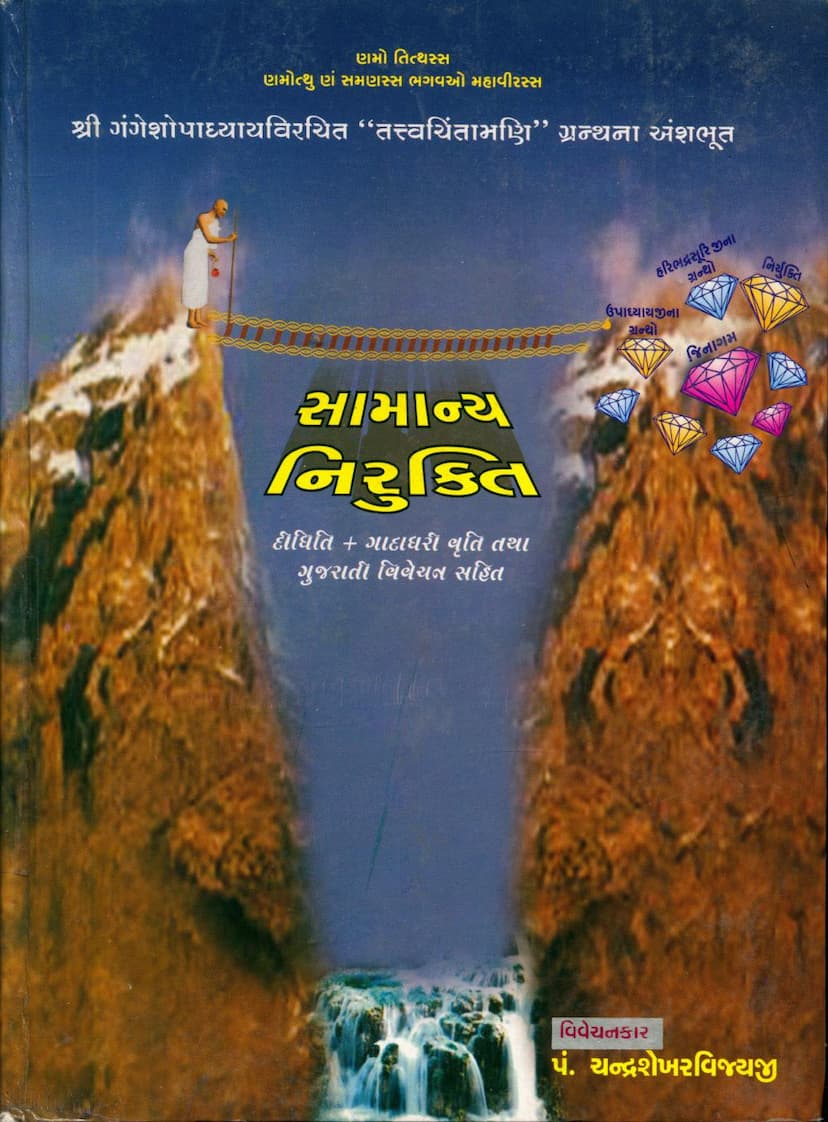Samanya Nirukti
Added to library: September 2, 2025

Summary
Here's a comprehensive summary of the Jain text "Samanya Nirukti" by Chandrashekharvijay, based on the provided pages:
Title: Samanya Nirukti (સામાન્ય નિરુકિત) Author: Pt. Chandrashekharvijay (પં. ચન્દ્રશેખરવિજયજી) Publisher: Kamal Prakashan Trust (કમલ પ્રકાશન ટ્રસ્ટ) Context: This book is an excerpt from Pt. Chandrashekharvijay's commentary on the "Tattvachintamani" (તત્ત્વચિંતામણિ) by Shri Gangeshopadhyay. It is further elucidated with the commentaries "Didhiti" (દીધિતિ) by Shri Raghunathshiromani (શ્રીરઘુનાથશિરોમણિ) and "Gadadhari" (ગાદાધરી) by Shri Gadadhar Bhattacharya (શ્રીગદાધરભટ્ટાચાર્ય).
Core Subject Matter:
The "Samanya Nirukti" (General Definition/Explanation) primarily deals with the Hetvābhāsa (હેત્વાભાસ) in Indian logic, specifically from a Jain perspective, though it engages with and explains the nuances of the Nyaya school's philosophical framework. Hetvābhāsa refers to fallacies or invalid arguments in syllogistic reasoning, which appear to be valid but are not.
Key Themes and Content:
-
Introduction to Navya-Nyaya: The book is situated within the context of Navya-Nyaya (નવ્ય ન્યાય), a significant school of Indian philosophy known for its rigorous analytical and logical methods. The author acknowledges the seminal work of Shri Gangeśa Upādhyāya as the foundation of Navya-Nyaya.
-
Purpose of Studying Nyaya for Jains: The preface and introductory sections explain why Jain scholars study Nyaya texts, which originate from a non-Jain philosophical school (primarily the Nyaya school). The main purposes are:
- Understanding and Refuting Other Philosophies: To study the concepts and arguments of Naiyāyikas (followers of Nyaya), identify their differences and errors from the Jain perspective, and thereby establish the supremacy of Jain teachings through refutation.
- Sharpening Intellect: To hone one's own intellect and logical reasoning skills through the dialectical debates and refutations found in Nyaya texts. This refined intellect then becomes sharper and more effective when studying profound Jain scriptures, acting as a guide in comprehending their deeper mysteries.
-
Structure of the Text: The book presents the "Samanya Nirukti" text, which discusses the three fallacies (Hetvābhāsa) – specifically related to the analysis of the 'Hetu' (reason) in a syllogism.
- It elaborates on the three characteristics of a valid Hetu (Sadhetu): Paksha-sattva (presence in the minor term), Sapaksha-sattva (presence in the major term), Vipaksha-asatva (absence in the dissimilar term), Abādhitatva (non-contradiction), and Asat-pratipakshitatva (non-refutation by counter-argument).
- It then delves into the general definition of Hetvābhāsa and its classification into five main types:
- Bādh (Objection/Contradiction)
- Satyatiproks (Contradicted by a counter-argument)
- Vyabhicāra (Irregularity/Fallacy of Undistributed Middle)
- Virodh (Contradiction)
- Asiddhi (Unproven/Fallacy of Unestablished Premise)
- The text meticulously explains each of these fallacies with examples and elaborations, often referencing the commentaries of Didhiti and Gadadhari for deeper insights.
-
Commentaries and Elaborations: The book is enriched by the detailed Gujarati commentary of Pt. Chandrashekharvijayji. He not only translates but also explains the complex logical arguments of the original Sanskrit texts and their commentaries in a way that is accessible to Gujarati readers. The author's own extensive study of Navya-Nyaya texts and his practice of writing detailed commentaries is highlighted, demonstrating his deep engagement with the subject.
-
Author's Background and Motivation: The preface reveals Pt. Chandrashekharvijayji's background as a disciple of the respected Acharya Shrimad Vijay Prem Surishwarji Maharaj. He mentions his extensive study of Nyaya texts, including writing over 11,000 pages of commentary. The publication of these commentaries is seen as a fulfillment of a desire to make these difficult philosophical texts more accessible to students and scholars. The Kamal Prakashan Trust is also noted for making these books available free of charge to Jain Bhandars, students, and scholars.
-
Key Logical Concepts Discussed:
- Hetu (Reason): The middle term in a syllogism, essential for establishing the conclusion.
- Sadhetu: A valid reason.
- Hetvābhāsa: An invalid reason that appears valid.
- Vyāpti (Invariable Concomitance): The essential relationship between the middle and major terms, crucial for valid inference.
- Tarka (Reasoning/Argumentation): The process of logical deduction.
- Prakaraṇa (Topic/Subject): The subject matter of discussion.
- Pramāṇa (Means of Valid Knowledge): While not the main focus, the underlying logical framework relies on established Pramāṇas.
Overall Significance:
"Samanya Nirukti" by Pt. Chandrashekharvijay is a scholarly work that bridges the complex world of Indian logic (Navya-Nyaya) with Jain philosophy. It not only provides a detailed explanation of the concept of Hetvābhāsa but also underscores the intellectual rigor and analytical skills required for deep philosophical study within the Jain tradition. The commentary makes these often-intimidating texts accessible to a wider audience, promoting the study of logic and philosophy among Jain scholars and students. The dedication to making these texts freely available highlights the publisher's commitment to preserving and propagating Jain knowledge.